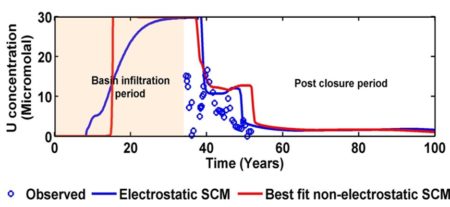Arora et al. (2017) developed a simple non-electrostatic model through a step-by-step calibration procedure to describe U plume behavior at the Savannah River site. This simple model was found to be more numerically-efficient than a complex mechanistic model with electrostatic correction terms in predicting long-term U behavior at the site and by extension other uranium contaminated sites.
Uranium geochemistry has been extremely challenging to describe and predict. Although complex mechanistic models have been used to describe U sorption in field settings, there is significant uncertainty in model predictions due to scarce field data and modeling assumptions concerning mineral assemblage and subsurface heterogeneity. This study demonstrates that a simpler non-electrostatic model is a powerful alternative for describing U plume evolution at the Savannah River Site (SRS) because it can describe U(VI) sorption much more accurately than a constant coefficient (Kd) approach, while being more numerically efficient than a complex model with electrostatic correction terms. This study provides valuable insight into predicting uranium plume persistence from contaminated sites using simple non-electrostatic models.
Summary
The aim of this study was to test if a simpler, semi-empirical, non-electrostatic U(VI) sorption model (NEM) could achieve the same predictive performance as a model with electrostatic correction terms in describing pH and U(VI) behavior at multiple locations within the SRS F-Area. Modeling results indicate that the simpler NEM was able to perform as well as the electrostatic surface complexation model especially in simulating uranium breakthrough tails and long-term trends. However, the model simulations differed significantly during the early basin discharge period. Model performance cannot be assessed during this early period due to a lack of field observations (e.g., initial pH of the basin water) that would better constrain the models. In this manner, modeling results highlight the importance of the range of environmental data that are typically used for calibrating the model.
Citation
Arora, B., Davis, J. A., Spycher, N. F., Dong, W., & Wainwright, H. M. (2017). Comparison of Electrostatic and Non‐Electrostatic Models for U (VI) Sorption on Aquifer Sediments. Groundwater. doi: 10.1111/gwat.12551

